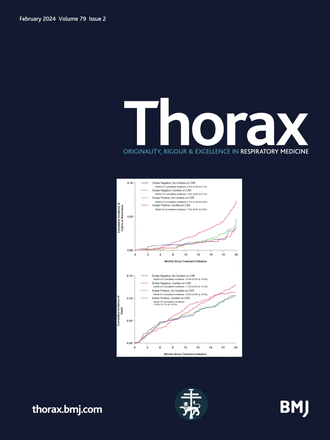三个自身免疫性间质性肺病队列中间质性肺病的定量放射学特征对免疫调节治疗反应的影响
IF 9
1区 医学
Q1 RESPIRATORY SYSTEM
引用次数: 0
摘要
本文章由计算机程序翻译,如有差异,请以英文原文为准。
Impact of quantitative radiological features of interstitial lung disease on immunomodulatory treatment response in three autoimmune interstitial lung disease cohorts
Background The defining radiological features of autoimmune interstitial lung disease (ILD) are ground glass opacification (GGO) and fibrosis. The associations between these features and physiological response to immunomodulation remain unclear. Methods This study leveraged three autoimmune ILD cohorts: two with systemic sclerosis (SSc) and one with rheumatoid arthritis (RA) which were selected for inherent differences in fibrotic extents/patterns. Linear regression models examined associations between baseline quantitative GGO, fibrosis, their ratio and forced vital capacity (FVC)%-predicted changes after 12 months of immunomodulatory therapy. Results Patients with SSc-ILD (N=262) exhibited a higher GGO-to-fibrosis ratio compared with patients with RA-ILD (N=130) (mean ratio 3.0 vs 0.25). Increased GGO-to-fibrosis was not associated with improved FVC%-predicted in any cohort. Conversely, in patients with SSc-ILD treated with cyclophosphamide (CYC), increased fibrosis (estimate 0.17 (95% CI 0.003, 0.33); p=0.04) and increased GGO (estimate 0.15 (95% CI 0.004, 0.30); p=0.044) were both significantly associated with FVC% improvement. Given the negative direction of the estimate for GGO-to-fibrosis ratio (estimate −0.33 (95% CI −0.61, –0.06); p=0.016), CYC was associated with greater FVC% improvement in patients with a higher degree of fibrosis relative to GGO. No significant correlation was seen in patients with SSc-ILD treated with mycophenolate (N=56) or in patients with RA-ILD treated with immunomodulation (N=130). Discussion Increased quantitative GGO relative to fibrosis was not significantly associated with improved response to immunomodulation in patients with RA-ILD and SSc-ILD. However, increased quantitative fibrosis and GGO extent were associated with improved response to CYC in SSc-ILD. More research is needed to understand how to use radiological features to guide treatment selection in ILD. Data are available upon reasonable request.
求助全文
通过发布文献求助,成功后即可免费获取论文全文。
去求助
来源期刊

Thorax
医学-呼吸系统
CiteScore
16.10
自引率
2.00%
发文量
197
审稿时长
1 months
期刊介绍:
Thorax stands as one of the premier respiratory medicine journals globally, featuring clinical and experimental research articles spanning respiratory medicine, pediatrics, immunology, pharmacology, pathology, and surgery. The journal's mission is to publish noteworthy advancements in scientific understanding that are poised to influence clinical practice significantly. This encompasses articles delving into basic and translational mechanisms applicable to clinical material, covering areas such as cell and molecular biology, genetics, epidemiology, and immunology.
 求助内容:
求助内容: 应助结果提醒方式:
应助结果提醒方式:


